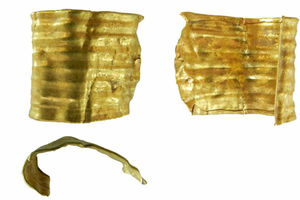'One of the most important Bronze Age finds': Shropshire gold bead declared treasure
A gold bead declared treasure by Shropshire's coroner has been described as "one of the most important Bronze Age finds discovered in the county".

The bead, which was discovered by a metal detectorist in the Wem area on September 18 last year, is said to be from the early Bronze Age – making it around 4,000 years old.
Peter Reavill, finds liaison officer for Shropshire, said it is hoped that the item will be able to be bought by Shropshire Museums to be put on display at Much Wenlock Museum.
The item was ruled as treasure by John Ellery, Shropshire coroner, at a treasure inquest held at Shirehall, Shrewsbury.
The finding of the bead was initially reported to Vanessa Oakden, finds liaison officer for Cheshire, who wrote a report describing it as "a small rectangular strip of folded gold with one decorated surface. One edge of the strip is complete having been cut regularly with a slightly thickened rim. The other side has been torn resulting in a sharp undulating edge. The decoration consists of eight fine, straight ridges and grooves. It measures length 17mm, width 14mm, weight 2.1g."
Mr Reavill said the find is of great historical importance, and is from a period when people first began to work with gold.
He said: "The gold fragment is relatively small but it is one of the most important Bronze Age finds discovered in Shropshire. It is around 4,000 years old being made at the very beginning of the Bronze Age when gold was incredibly scarce and important. Archaeologists call this period the Chalcolithic and it is when people first started to work with gold, copper and tin. The original owner would have been a very important person within the community and the find may have been passed down before being deposited. All we have is this tiny fragment and it is possible that it may have been lost after being damaged. It is much more likely that it was deliberately buried as a grave good in a 'Beaker Burial' under a round mound. The mound has subsequently been ploughed out by centuries of cultivation and all that remains of the grave is this small gift."
Mr Reavill said that it is hoped that the funds can be raised to buy the item to keep it in the county.
He said: "Shropshire Museums have expressed an interest in acquiring the find for the people of Shropshire - with the hope that it will be displayed in the Much Wenlock Museum. Now the find has been declared treasure - it will be valued by the Governments Treasure Valuation Committee and the museum will be given a period of grace to raise the relevant funds. These monies will be paid to both the finder and landowner as a reward under the Treasure Act (1996)."





